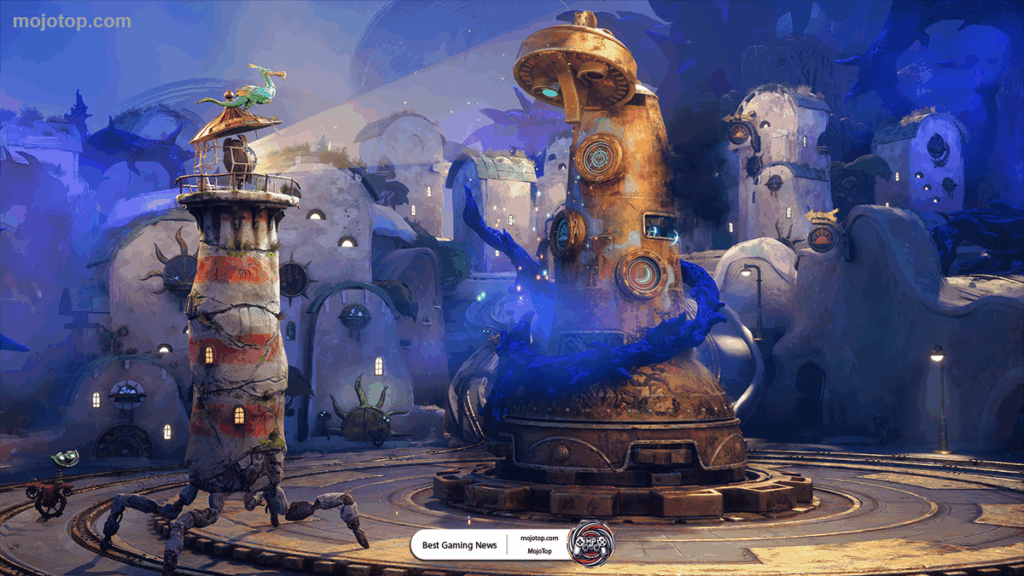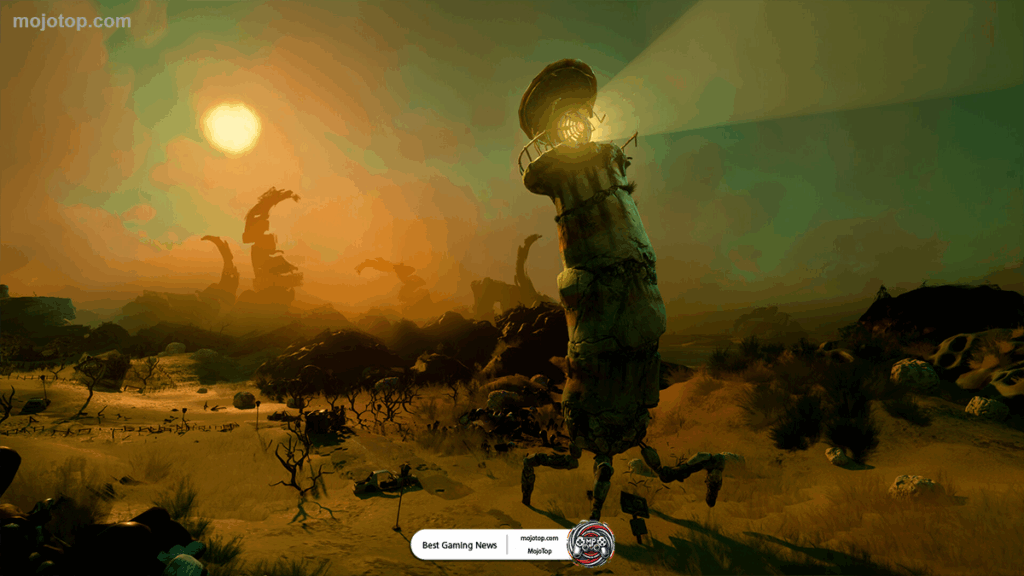Keeper: 3 Facts You Must Know Before Playing
Explore the world of Keeper in our Keeper game review, covering story, gameplay, and why this Double Fine adventure deserves your attention.
One of the most compelling aspects of Keeper is how the game tells its story largely without words. In this Keeper game review, the developers at Double Fine Productions prioritize mood, environment, and visual narrative to immerse players in a surreal adventure. As the forgotten lighthouse awakens and gains legs, and is joined by a seabird companion named Twig, the world around them becomes both character and canvas.
The atmosphere is built through interactions with light: shining the beam reveals hidden pathways, activates environmental elements, and causes flora and fauna to react or even transform. These light-based puzzles aren’t just gameplay mechanics; they are storytelling devices. Every beam cast, shadow manipulated, or crank turned contributes meaning. The sense of companionship between Lighthouse and Twig is illustrated through motion, through the way environments respond—not through spoken dialogues.
Surreal visuals are another pillar in Keeper’s atmospheric storytelling. Inspired by the works of surrealist art and fantasy films like The Dark Crystal, the environments are lush, otherworldly, often bioluminescent. Tendrils of plant life, strange rock formations, color and light play in ways that evoke wonder and unease simultaneously. In this Keeper game review, those visuals are not merely decoration but are essential in communicating themes: change, isolation, purpose.
Sound design and ambient audio further augment the mood in Keeper. Rather than relying on voiceovers, the game uses environmental sounds, the creaks and sighs of the world, soft bird calls, shifting wind, and subtle musical cues to evoke tension, serenity, or curiosity. These audio elements reinforce the visual storytelling, making exploration feel intimate and often contemplative. Together with the art, gameplay, and setting, they help Keeper stand apart in its narrative approach.
Overall, the atmospheric storytelling in Keeper showcases how narrative can be woven through design, not text. According to early previews and the Steam description, this is a story for people who enjoy exploration, mystery, and slow revelations. In comparing similar titles, Keeper aligns with other puzzle-adventure games that favor mood and environment (such as Journey or Inside) over explicit plot mechanics. These design choices make Keeper’s storytelling approach a central feature worth knowing before playing.
You can also check our article on a title that is already being considered a Game of the Year candidate.

Puzzle and Adventure Gameplay Mechanics
In this Keeper game review, one of the standout features is how the puzzle and adventure elements are designed to complement each other, creating an experience that feels intuitive yet rich in discovery. Keeper, developed by Double Fine and Lee Petty, uses its gameplay mechanics not just for challenge, but as part of the narrative itself.
Keeper uses the lighthouse’s beam of light as the central tool for interacting with the world. Players will switch between unfocused and focused modes of the beam. In unfocused mode, the light influences flora and fauna, causing subtle changes in the environment and sometimes triggering growth or reaction. In focused mode, the beam becomes more precise, used to transform objects, reveal hidden pathways, or solve more complex puzzles. This mechanic serves multiple purposes: it’s a puzzle-solving device, an environmental interaction tool, and part of the storytelling, reinforcing the sense that the world is alive and responsive.
An important component of the adventure mechanics in Keeper is the bird companion (Twig) that accompanies the lighthouse. This companion isn’t merely decorative. The bird plays a role in guiding through the world, flagging secrets, activating environmental triggers, and helping solve environmental puzzles. Environmental puzzles often rely on combining the light beam and bird-enabled interactions—such as perches the bird can reach to operate cranks or levers.
Keeper places strong emphasis on exploration. From gameplay previews, it’s clear that discovering what each part of the world does is a big part of the fun. Objects, creatures, and passages respond to light in unexpected ways, so players often learn through experimentation—what new effect appears when the light hits a mirror, or how shadow creatures move away when illuminated. The controls are designed to be simple and approachable, avoiding overwhelming players with too many buttons or complex combos. This encourages wandering, observation, and solving puzzles at one’s own pace.
In this Keeper game review, the balance between tranquil exploration and mental challenge is central. Keeper isn’t trying to be relentlessly difficult; rather, it weaves together quieter moments—walking across alien landscapes, interacting with environmental details—with peak puzzle moments where careful timing, observing change, and using the light mechanics and the bird companion matter. This balance makes the puzzle-adventure gameplay feel dynamic: you’re not just solving puzzles, you’re participating in an odyssey where every solved puzzle leads to more curiosity.
Art Style and Double Fine’s Creative Touch
One of the most striking things about Keeper is its visual language—how every frame feels like a painting, every scene like it’s designed to provoke curiosity. In this Keeper game review, the art direction plays a central role in communicating tone, setting, and emotion even before you move or solve a puzzle.
Keeper embraces surrealism in its environmental design. Lee Petty, creative lead at Double Fine, has cited influences like Salvador Dalí and fantasy cinema (e.g. The Dark Crystal) when discussing the aesthetics. The world through which the lighthouse traverses is lush, tangled, and dream-like: strange tendrils of plant life, warped rock formations, fog-shrouded peaks, and bioluminescent flora all combine to craft a setting where the unnatural feels familiar, and beauty often sits side by side with decay.
In the absence of spoken dialogue, artistry shows itself in movement. The lighthouse itself is a character: after awakening, it regains life not just through its structure (cracked masonry, broken form) but through the graceful/unsteady motion of its newly formed legs. Twig, the seabird companion, is animated in ways that imply curiosity, responsiveness, and trust. Tiny environmental animations—plants glimmering, creatures stirring—add texture and life to spaces you might simply walk through in other games. These animations help the narrative unfold visually.
Color in Keeper is not just aesthetic; it’s storytelling. The palette shifts between muted browns and grays for abandoned, decaying areas, and vibrant greens, purples, pinks, or bioluminescent tones where life or transformation is occurring. Light is used strategically: a warmer glow implies safety or discovery, shadows convey mystery or decay. In previews, lighting effects—like shafts piercing through foliage, softly glowing fungi, mist that refracts light, floating particles—add depth and a tactile sense of the environment.
Keeper is being developed in Unreal Engine 5.5, which allows Double Fine’s artists and technical team to craft dynamic shader effects, morphing geometry, and fluid environmental transitions. For example, environments respond to light in ways that are more than cosmetic—rocks might transform, vines grow or retract; weather and vegetation shift; fog and mist amplify the sense of scale and mystery. All of this contributes to immersion: you’re not just seeing the world, you feel its texture.

Conclusion
Keeper offers a rare blend of artistry, calm exploration, and thoughtful puzzle design that makes it a standout in the upcoming lineup of atmospheric adventure games. From what has been revealed so far, its strengths are not just in visuals, but in how mood, interaction, and environment are woven together to form an emotionally resonant experience. If you value games that respect your pace and invite wonder, this is one to watch.
One of the major draws is how Keeper defines its gameplay around discovery and reflection rather than combat or high-stress action. According to previews, players won’t face enemies or die — the focus is on experiment, wonder, and learning what each new environment can teach you. It’s a narrative told without dialogue, yet it communicates themes — of change, companionship, renewal — through behavior of light, the interaction with flora and fauna, and the presence of the seabird, Twig.
The creative vision behind Keeper is also a big reason it stands out. Double Fine and director Lee Petty have taken the opportunity, afforded by Xbox Game Studios’s backing, to lean fully into experimental design. Surreal visuals, ambient soundscapes, and animation that gives inanimate objects character all serve to create a unique, immersive world. All of this shows up in Steam’s description too, which highlights its “atmospheric puzzle adventure,” “a story told without words,” and its themes of metamorphosis and misunderstood purpose.
Finally, Keeper is shaping up to be accessible without compromising artistry. The simplicity of its mechanics — walking, shining a light, guiding the bird companion — combined with the open-ended journey makes it approachable even for players who prefer more contemplative, story-rich games. There are hints that the game will be roughly 8-10 hours long, giving time enough for exploration and emotional depth, but not overstaying its welcome.
In summary, Keeper is worth playing because it promises to deliver an experience that matters beyond scoreboards: a game rich in atmosphere, subtle storytelling, introspective puzzles, and artistic risk. If this Keeper game review has shown anything, it’s that Keeper offers something rare — a chance to wander, reflect, and be moved, not just challenged.
Quick Overview
| Feature | Overview |
|---|---|
| Developer | Double Fine Productions |
| Genre | Atmospheric puzzle-adventure |
| Core Gameplay | Light-based puzzles, exploration with Twig the bird |
| Visual Style | Surreal, inspired by Salvador Dalí and fantasy cinema |
| Platforms | Steam (PC), Xbox Series X |
| Release Date | October 17, 2025 |

